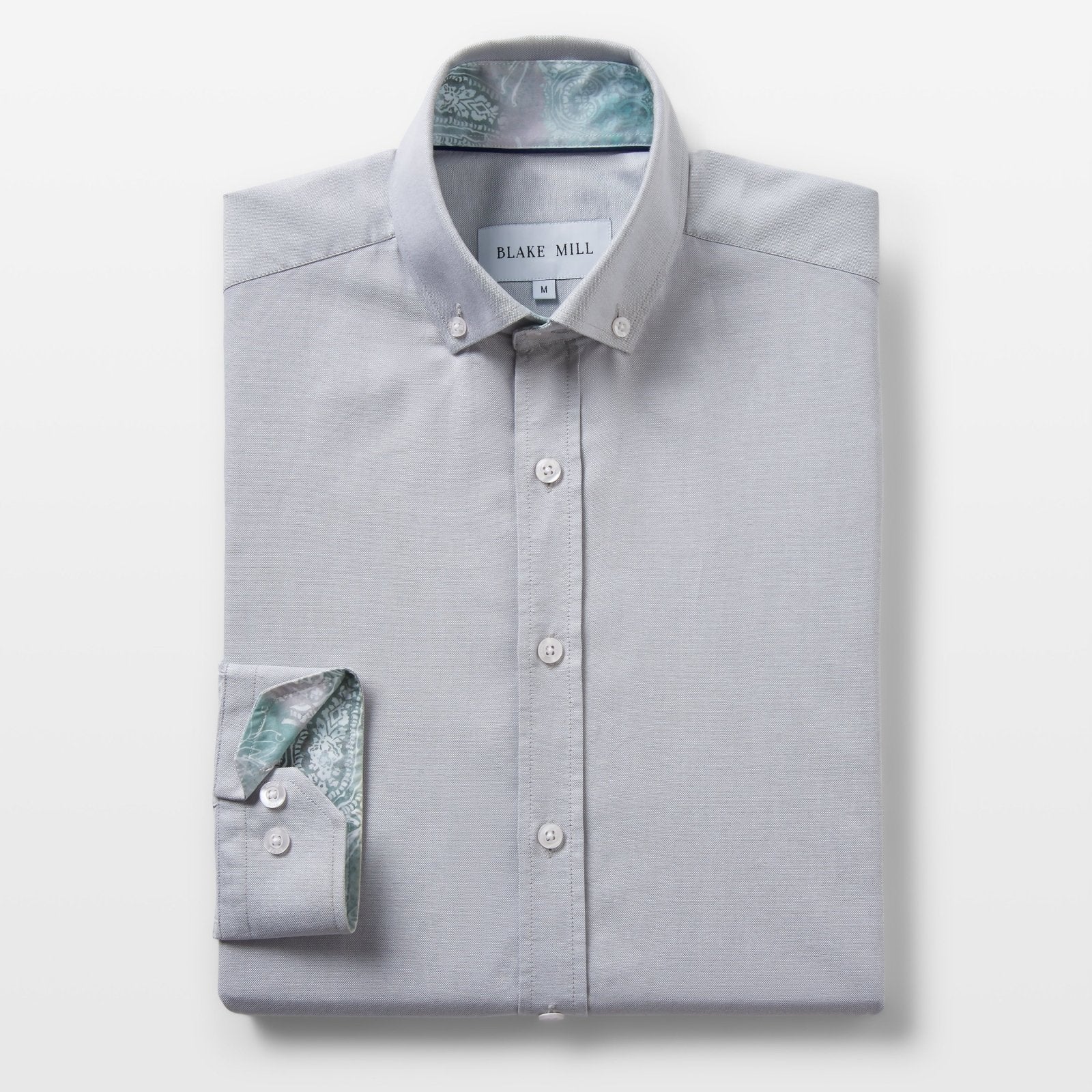How to Care for Your Oxford Shirts: Tips for Longevity
Understanding Oxford Shirts and how to keep the looking their best.
Before we delve into the care tips, let's understand what makes Oxford shirts unique. Oxford shirts are a type of dress shirt made from 100% cotton fabric. They are known for their softness, breathability, and versatility. Oxford shirts often feature a button-down collar and are commonly worn in formal and semi-formal settings. They may also come with collar stays to keep the collar looking crisp and sharp. Oxford shirts are available in different fabrics, including plain, twill, and pinpoint, each with its own distinctive texture and appearance.
What Makes Oxford Shirts Unique?
Oxford shirts offer a unique combination of style, comfort, and durability. Unlike other dress shirts, which may be more formal and restrictive, Oxford shirts have a more relaxed and casual look, making them versatile for various occasions. Their 100% cotton fabric ensures breathability and comfort, even during long hours of wear.
Proper care is essential to maintain the quality and longevity of your Oxford shirts. By following the right care routine, you can ensure that your shirts retain their shape, colour, and overall appearance, allowing you to make a lasting impression wherever you go. From washing techniques to storage solutions, each step plays a crucial role in preserving the integrity of your Oxford shirts and ensuring they look as good as new, even after multiple wears.
The History and Evolution of Oxford Shirts
The cotton Oxford shirt has a rich history and has evolved over time to become a staple in every well-dressed individual's wardrobe. Its origins can be traced back to the 19th century in Scotland, where it was initially used as a sports shirt for polo players. The Oxford shirt gained popularity in the early 20th century when it became associated with the prestigious Oxford University.
One of the distinguishing features of the Oxford shirt is its button-down collar, which was introduced by John E. Brooks, grandson of the founder of Brooks Brothers. The button-down collar was created to keep the collar in place during sporting activities. Today, Oxford shirts are worn not only for sports but also as a classic dress shirt for formal and semi-formal occasions. They often come with collar stays to ensure a crisp and polished look.

Pre-Wash Care for Oxford Shirts
Before washing your Oxford shirts, it is essential to pay attention to pre-wash care. This includes reading the care label to understand the manufacturer's recommendations for washing and caring for the shirt. Additionally, it is important to treat any stains or spills on the shirt before washing them. Treating stains promptly can help prevent them from setting into the fabric and becoming more difficult to remove. By giving pre-wash care the attention it deserves, you can ensure that your Oxford shirts stay in pristine condition for a long time.
Oxford shirts offer style, comfort, and durability in a casual look. Their 100% cotton fabric ensures breathability even during long wear. Proper care is crucial for maintaining their quality. Follow the right care routine to preserve their shape, colour, and appearance for lasting impressions.
Pre-Treating Stains on Oxford Shirts
The Oxford shirt, originating in 19th-century Scotland for polo players, evolved to become a wardrobe staple. Popularised by Oxford University in the early 20th century, it features a signature button-down collar introduced by John E. Brooks of Brooks Brothers for sports. Today, Oxford shirts are worn for both formal and casual occasions, offering a timeless and polished look with collar stays.
Washing Your Oxford Shirts
When it comes to washing your Oxford shirts, it's important to follow the correct washing technique to ensure their longevity and maintain their pristine appearance. In general, it is recommended to machine wash your shirts using cold water or warm water on a delicate cycle. Cold water helps to preserve the colour and prevents shrinkage, while warm water can help remove dirt and stains more effectively.
Before washing, make sure to fasten any buttons and turn the shirt inside out to protect the outer surface from abrasion. This will also help to reduce the chances of wrinkles and preserve the overall quality of the fabric. Use a gentle detergent that is suitable for delicate fabrics and avoid using bleach, as it can damage the fabric and cause discoloration.
Choosing the Right Detergent
Oxford shirts offer style, comfort, and durability in a casual look. The 100% cotton fabric ensures breathability even during extended wear. Proper care is essential for maintaining their quality. Follow the correct care routine to preserve their shape, colour, and appearance for lasting impressions.
Machine Wash vs. Hand Wash: Best Practices
When it comes to washing your Oxford shirts, you may be wondering whether it's better to machine wash or hand wash them. Both methods have their pros and cons, and the best choice depends on your preference and the specific care instructions provided by the manufacturer. Here are some best practices for each method:
Machine Wash:
- Use a delicate cycle to protect the fabric from excessive agitation and friction.
- Turn the shirts inside out to minimise abrasion on the outer surface.
- Wash similar colours together to prevent colour bleeding.
- Avoid overloading the washing machine to ensure proper cleaning and rinsing.
Hand Wash:
- Fill a basin or sink with lukewarm water and add a small amount of mild detergent.
- Gently agitate the shirts in the water, paying attention to stained or soiled areas.
- Rinse thoroughly with clean water until all soap residue is removed.
- Press out excess water without twisting or wringing the fabric.
Ultimately, the choice between machine washing and hand washing depends on personal preference and the specific care instructions provided by the manufacturer. Whichever method you choose, always handle the shirts with care to maintain their quality and longevity.
The Importance of Water Temperature
The water temperature you choose when washing your Oxford shirts can significantly impact their overall condition and lifespan. It's important to understand the effects of different water temperatures on the fabric to make the right choice.
Cold water is generally recommended for washing Oxford shirts, as it helps to preserve the colour and prevent shrinkage. Cold water is particularly beneficial for shirts made from delicate fabrics or those prone to shrinking. However, if your shirts are heavily soiled or require a deeper clean, you can opt for warm water. Warm water can help remove dirt and stains more effectively but should be used with caution to avoid damaging the fabric.
Using hot water is generally not recommended for washing Oxford shirts, as it can cause shrinkage and fading, especially for 100% cotton shirts. Hot water can also weaken the fabric fibres and shorten the lifespan of your shirts. Stick to cold or warm water for the best results in maintaining the quality and appearance of your Oxford shirts.
Drying and Ironing Oxford Shirts
To wash Oxford shirts properly: machine wash with cold or warm water on a delicate cycle. Fasten buttons, turn inside out before washing. Use gentle detergent; avoid bleach for fabric longevity and appearance.
To Tumble Dry or Not to Tumble Dry?
Oxford shirts offer style, comfort, and durability in a casual look. The 100% cotton fabric ensures breathability even during extended wear. Proper care is essential for maintaining their quality. Follow the correct care routine to preserve their shape, colour, and appearance for lasting impressions.
Ironing Techniques for a Crisp Finish
Ironing your Oxford shirts is a crucial step in achieving a crisp and polished finish. Follow these ironing techniques to maintain the quality and appearance of your shirts:
- Start with a clean and well-maintained iron. Check that the soleplate is clean and free from any residue that could transfer onto your shirts.
- Set your iron to the appropriate heat setting for cotton fabrics. Too high a heat can scorch or burn the fabric, while too low a heat may not effectively remove wrinkles.
- Iron your shirts inside out to protect the outer surface from direct heat. This is especially important for shirts with delicate fabrics or printed designs.
- Start with the collar and cuffs. Use the pointed end of the ironing board to press the collar and cuffs, being careful to avoid any collar stays. If the collar stays are removable, take them out before ironing.
- Move on to the body of the shirt. Lay the shirt flat on the ironing board and smooth out any creases with the iron. Pay attention to the front placket, sleeves, and back of the shirt.
- Hang the shirt immediately after ironing to allow it to cool and set the shape. Using collar stays can help maintain the crispness of the collar.
By following these ironing techniques, you can achieve a crisp and polished finish that enhances the overall appearance of your Oxford shirts.
Proper Storage Solutions
Proper storage is essential for maintaining the quality and appearance of your Oxford shirts. Here are some tips for storing your shirts:
- Hang your shirts on a sturdy hanger to prevent wrinkles and maintain their shape. Use hangers with wide shoulders to distribute the weight evenly.
- Store your shirts in a cool, dry place, away from direct sunlight. Exposure to sunlight can fade the fabric and cause discoloration.
- Avoid overcrowding your wardrobe. Give your shirts enough space to breathe and prevent creasing.
By following these storage solutions, you can ensure that your Oxford shirts remain in pristine condition and ready to wear whenever you need them.
Hanging vs. Folding: What’s Best for Oxford Shirts?
Tips for Preventing Wrinkles and Preserving Shape
Ironing Oxford shirts is essential for a polished look. Follow these techniques:
- Use a clean iron at the right heat for cotton.
- Iron inside out for delicate fabrics or prints.
- Start with the collar and cuffs, then the body.
- Hang immediately after ironing to set shape and maintain crispness.
Spot Treatment and Stain Removal
Common Stains and How to Remove Them
When it comes to storing your Oxford shirts, the age-old debate of hanging vs. folding often arises. Both methods have their advantages, but the best option depends on your storage space and personal preference.
Hanging your shirts on hangers is a great way to prevent wrinkles and maintain the shape of the collar and cuffs. It also allows for easy access and visibility, making it convenient when selecting your outfit. To preserve the crispness of the collar, use collar stays and ensure that the hanger is wide enough to support the shoulders of the shirt.
On the other hand, folding your shirts neatly and placing them in a drawer or shelf can be a space-saving option. Folding can help minimise the risk of shoulder bumps and maintain the overall shape of the shirt. However, be mindful of creases that may form during folding, especially on the sleeves and body.
Ultimately, the choice between hanging and folding comes down to personal preference and the available storage space. Consider your needs and the condition of your shirts to determine the best storage method for you.
DIY Natural Stain Removers
Wrinkles can detract from the polished appearance of your Oxford shirts. To prevent wrinkles and preserve their shape, follow these tips:
- Hang your shirts immediately after washing or ironing. This allows them to air out and helps the fabric regain its shape.
- Avoid overcrowding your wardrobe or drawer. Giving your shirts enough space to breathe helps prevent excessive wrinkling and creasing.
- Invest in high-quality hangers that provide proper support to the shoulders of your shirts. This helps maintain the shape and prevents unsightly shoulder bumps.
- If you notice wrinkles on your shirts, lightly mist them with water and let them hang for a few minutes. The moisture will help relax the fabric and release the wrinkles.
By following these tips and giving your Oxford shirts the proper care they deserve, you can prevent wrinkles and ensure their longevity, allowing you to enjoy their crisp and polished look for years to come.
Regular Maintenance Tips
Promptly treating stains is crucial to prevent them from setting into the fabric. As soon as you notice a stain, gently blot it with a clean cloth or paper towel to remove any excess liquid. Avoid rubbing the stain, as it can spread and make the situation worse.
Next, apply a small amount of stain remover to the affected area and gently work it into the fabric using a soft brush or your fingers. Allow the stain remover to penetrate the fabric for a few minutes before rinsing it with cold water.
Avoid exposing stained shirts to direct sunlight, as it can set the stain and make it more difficult to remove. If the stain persists, repeat the treatment process or consult a professional cleaner for further assistance.
By treating stains promptly and using the right techniques, you can effectively remove most stains and ensure that your Oxford shirts remain in impeccable condition.
Refreshing Your Oxford Shirt Between Washes
When storing Oxford shirts, the debate between hanging and folding arises. Hanging prevents wrinkles and maintains collar and cuff shape, offering easy access to your outfit. Use collar stays and a wide hanger for collar crispness.
Folding neatly in a drawer saves space, minimising shoulder bumps and maintaining shirt shape. Be cautious of creases that may form on sleeves and body during folding.
Choose between hanging or folding based on personal preference and storage space availability. Consider your shirt's condition to decide the best storage method for you.
Mending Tears and Fixing Buttons
If you prefer natural alternatives to chemical stain removers, there are several DIY options you can try. Here are a few natural stain removers that can effectively tackle common stains:
- Lemon juice: The acidic properties of lemon juice can help remove stains, especially on white shirts. Apply lemon juice directly to the stain and let it sit for a few minutes before rinsing with cold water.
- Baking soda: Create a paste by mixing baking soda with water and apply it to the stain. Gently rub the paste into the fabric, then rinse with cold water.
- Vinegar: Vinegar is a versatile natural stain remover. Mix equal parts vinegar and water and apply it to the stain. Let it sit for a few minutes before rinsing with cold water.
- Salt: Salt can absorb liquid and help lift stains. Sprinkle salt onto the stain and let it sit for a few minutes before rinsing with cold water.
These DIY natural stain removers can be effective in treating common stains while being gentle on the fabric of your Oxford shirts. Experiment with different methods to find the one that works best for you.
When to Seek Professional Care
Accidents happen, and stains are a reality of wearing clothes. Salvage your Oxford shirts with the right spot treatment techniques.
Promptly blot stains with a clean cloth to prevent setting. Apply stain remover, let it sit, then rinse with cold water. Avoid sunlight exposure to prevent setting.
For stubborn stains, repeat the process or seek professional help to maintain your Oxford shirts' impeccable condition.
Deciding Between Laundry and Dry Cleaning
Between washes, you can refresh your Oxford shirt and keep it looking and smelling fresh. Here's how:
- Hang your shirt in a well-ventilated area to allow it to air out.
- Use a fabric freshener spray to eliminate odours and give your shirt a pleasant scent.
- Steam your shirt to remove any wrinkles and refresh the fabric.
- Brush the fabric gently with a clothes brush to remove any dust or debris.
- Spot clean any stains or spills as soon as they occur to prevent them from setting.
By incorporating these simple steps into your regular care routine, you can extend the wearability of your Oxford shirt and maintain its freshness and appearance between washes.
Finding a Trusted Professional for Your Oxford Shirts
If you prefer natural stain removers, try these DIY options:
- Lemon juice: Removes stains on white shirts. Apply, wait, rinse.
- Baking soda: Create a paste, apply, rub, rinse.
- Vinegar: Mix with water, apply, wait, rinse.
- Salt: Absorbs liquid and lifts stains. Sprinkle, wait, rinse.
These gentle natural stain removers are effective on common stains for your Oxford shirts. Experiment to find your preferred method.
The Role of Fabric Softeners and Conditioners
While proper home care can go a long way in maintaining your Oxford shirts, there may be times when professional care is necessary. Here are some situations when you should consider seeking professional care:
- Stubborn stains that cannot be removed with home stain removal techniques.
- Delicate fabrics that require specialised cleaning methods.
- Shirts with complex designs or embellishments that require careful handling.
Professional cleaners have the expertise and equipment to effectively clean and care for your Oxford shirts, ensuring their longevity and maintaining their pristine appearance. When in doubt, it's always better to consult a professional to prevent any damage to your valuable garments.
To Use or Not to Use?
Deciding whether to launder or dry clean your Oxford shirt depends on several factors, including the fabric type, care instructions, and level of soiling. Here's a general guide to help you make the right decision:
Laundry (Machine Wash):
- Most Oxford shirts can be safely laundered at home using a gentle cycle and cold or warm water.
- Check the care label for specific instructions and follow them accordingly.
- Avoid using bleach or harsh detergents that can damage the fabric.
- Air dry your shirts to prevent shrinkage and excessive wrinkling.
Dry Cleaning:
- If your Oxford shirt is made from delicate or high-maintenance fabric, such as silk or wool, it's best to opt for dry cleaning.
- Dry cleaning uses specialised solvents that effectively remove dirt and stains without damaging the fabric.
- Take note of any embellishments or trims that may be sensitive to dry cleaning chemicals.
When in doubt, refer to the care label or consult a professional cleaner for advice on the best cleaning method for your Oxford shirt.
Natural Alternatives to Fabric Softeners
Finding a trusted professional cleaner for your Oxford shirts is crucial to ensure that your valuable garments are handled with care and expertise. Here are some tips for finding a reliable professional:
- Ask for recommendations from friends, family, or colleagues who have had positive experiences with professional cleaners.
- Read online reviews and ratings to get an idea of the cleaner's reputation and customer satisfaction.
- Inquire about the cleaner's experience in handling delicate fabrics and garments.
- Visit the cleaner's facility if possible to inspect their cleaning methods and facilities.
- Check if the cleaner offers any guarantees or warranties for their services.
A trusted professional cleaner will have the necessary expertise and equipment to clean and care for your Oxford shirts, allowing you to make a lasting impression with your well-maintained garments.
Learn about layering your Oxford shirts with other garments in our guide, 'Mastering Layering with Oxford Shirts: Expert Tips'.








